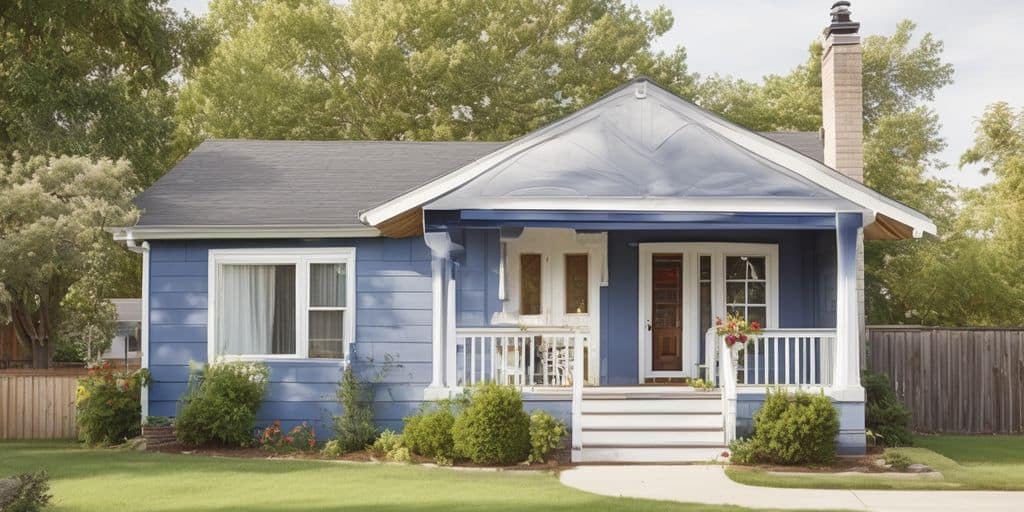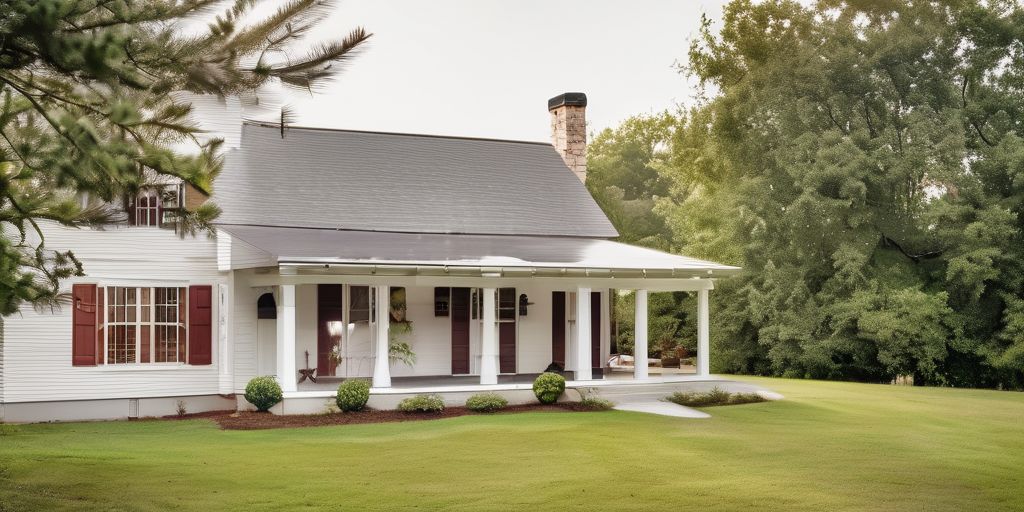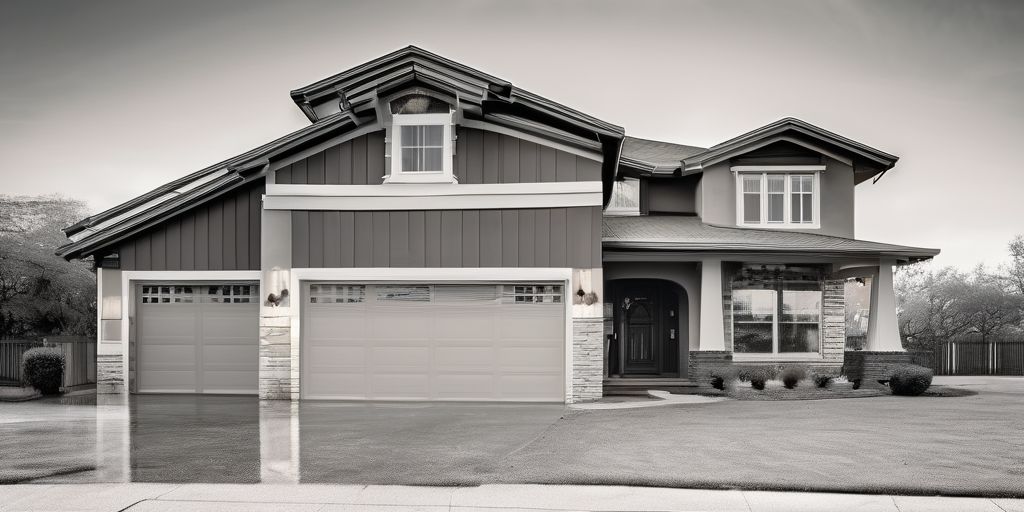Spray painting can be an efficient and effective way to achieve a smooth and professional finish on exterior surfaces. However, several common problems can arise during the process, potentially compromising the quality of the final result. This article aims to help you identify, prevent, and fix these common issues, ensuring a flawless and long-lasting finish.
Key Takeaways
- Proper adjustment of the spray equipment is crucial to avoid common painting problems.
- Environmental factors and operating skills significantly affect the quality of the spray paint finish.
- Using high-quality products and following best practices can prevent most spray painting issues.
- Identifying the root cause of a problem is the first step towards finding an effective solution.
- Preventive measures, such as using suitable primers and allowing sufficient flash time between coats, can save time and money in the long run.
Identifying and Fixing Chalking Issues
Causes of Chalking
Chalking is identified by the fine chalky powder that forms on the surface of a paint film. Although some chalking is a normal way in which paints self-clean when exposed to the sun and rain, excessive chalking can indicate paint failure. Possible causes include:
- Exposure to intense sunlight or pollution, such as acidic rain.
- Use of cheaper-quality exterior paint containing high levels of pigment extenders.
- Application of improper paint, like interior paint, in an exterior application.
- Over-thinning of paint before application.
- Failure to properly seal porous surfaces before painting.
Preventing Chalking
To prevent chalking, an exterior painter should:
- Use high-quality exterior paint designed to withstand environmental conditions.
- Ensure proper surface preparation, including sealing porous surfaces.
- Avoid over-thinning the paint.
- Regularly inspect and maintain the painted surfaces to address any early signs of chalking.
Steps to Fix Chalking
If chalking has already occurred, follow these steps to fix it:
- Remove the chalking by power washing or scrubbing with a trisodium phosphate cleaning solution.
- Rinse the area with clean water and let it completely dry.
- Prime the surface with a suitable primer.
- Repaint the area with a high-quality latex house paint.
Keeping the coating layer clean and tidy can help in maintaining the longevity of the paint job and prevent chalking issues.
Dealing with Poor Adhesion
Poor adhesion in exterior spray painting can lead to peeling, flaking, and an overall unsatisfactory finish. Proper surface preparation is crucial to ensure that the paint adheres well to the substrate. Here are some common causes, preventive measures, and repair techniques to deal with poor adhesion.
Common Causes of Poor Adhesion
- Insufficient surface preparation, such as inadequate sanding or cleaning.
- Using the wrong type of primer for the substrate.
- Applying paint in unfavorable weather conditions, like high humidity or extreme temperatures.
- Over-application of paint, leading to thick layers that don’t adhere well.
Preventive Measures
- Always thoroughly sand and clean the surface before painting.
- Use a suitable primer to create a stable base for the paint.
- Ensure the weather conditions are optimal for painting—avoid high humidity and extreme temperatures.
- Apply paint in thin, even layers to avoid over-application.
Combining spray and brush techniques ensures a durable and attractive finish, maximizing the efficiency and quality of your exterior paint job.
Repair Techniques
- Identify the areas where the paint is peeling or flaking.
- Sand back the affected areas to a stable surface.
- Clean the sanded areas thoroughly to remove any dust or debris.
- Apply a suitable primer to the sanded areas.
- Repaint the areas, ensuring to apply the paint in thin, even layers.
By following these steps, you can effectively address poor adhesion issues and achieve a long-lasting, professional finish for your exterior spray painting projects.
Managing Edge Mapping and Feather-Edge Lifting
What is Edge Mapping?
Edge mapping, also known as feather-edge lifting, is a common issue in spray painting. It appears as patches of finish that have lifted in ‘feathers’ around the edge of a repaired area. This problem often results from solvents in topcoats penetrating through areas of the undercoats.
Why Edge Mapping Occurs
Edge mapping occurs due to several reasons:
- Solvents in topcoats: These can penetrate through the undercoat layers.
- Inadequate barrier layer: Not using a suitable primer or sealer can lead to this issue.
- Improper surface preparation: Failing to properly sand and smooth the surface can cause feather-edge lifting.
Fixing Edge Mapping
To fix edge mapping, follow these steps:
- Remove the problem area: Sand down the affected area until smooth.
- Apply a suitable primer: Use a water-based, two-component primer or another sealer to create a good barrier layer.
- Repaint the area: Ensure even coverage and proper drying times to avoid further issues.
For precise exterior spray painting, attention to detail is crucial. Advanced strategies for complex surfaces, tricky edges, corners, and non-traditional shapes can help achieve professional results.
Remember, seasonal tips for exterior spray painting emphasize achieving even coverage, safety precautions, and maintaining spray-painted surfaces for durability and aesthetic appeal.
Avoiding Air Trapping in Your Finish
Recognizing Air Trapping
Air trapping occurs when tiny air bubbles rise to the surface of the paint and pop, leaving craters behind. Identifying these tiny craters early can save you a lot of trouble down the line.
Preventing Air Trapping
To prevent air trapping, follow these steps:
- Ensure your spray gun is adjusted properly.
- Use the correct air pressure setting.
- Keep your gun an appropriate distance away from the surface.
- Maintain clean equipment to avoid debris in your finish.
Solutions for Air Trapping
If you encounter air trapping, you can correct it by:
- Sanding the area with 1200-grit sandpaper.
- Polishing the sanded area to restore the finish.
Maintaining your spray gun and adjusting air pressure are key to avoiding air trapping issues.
Handling Bubbles in the Paint
Identifying Bubbles
Bubbles in paint can be a common issue, often appearing as small blisters on the painted surface. These bubbles can be caused by various factors, including improper surface preparation, high humidity, or using the wrong type of paint. Burst a few bubbles and examine the backside of blistered paint to determine if moisture or heat is the culprit.
Causes of Bubbles
Several conditions before spraying may lead to air bubbles and paint particles:
- The paint is not entirely shaken.
- The pressing force is sometimes large and sometimes small.
- The paint comes out of the nozzle intermittently, leading to the accumulation of paint.
- The surface moisture content is high, and the temperature is high.
- The air compressor or tube has moisture.
- The paint is poorly sealed to the object surface.
How to Eliminate Bubbles
To solve bubbles and paint particles, follow these steps:
- Clean the object first.
- Shake the paint well before spraying to ensure it is mixed evenly.
- Maintain consistency in force when spraying.
- Ensure your spray gun is adjusted properly and use the correct air pressure setting.
- Keep your gun an appropriate distance away from the surface.
- If a slight bubble is found, wait for the paint to dry and solidify, then wipe with a clean cotton cloth and continue to spray again.
- Sand the area with 1200-grit sandpaper and then polish it.
Remember, safety first: always wear PPE, ventilate the area, and maintain your equipment to prevent issues like bubbles in the paint.
Preventing and Fixing Streaking
Understanding Streaking
Streaking in exterior spray painting can be a frustrating issue, often resulting from improper technique or environmental factors. Test your gun’s spray pattern before starting the paint job to ensure even application. Holding the spray gun at a consistent 90-degree angle to the surface can also help prevent streaks.
Preventive Tips
To avoid streaking, follow these tips:
- Test your spray pattern before beginning.
- Avoid excessive film-build by spraying with a swift and even motion.
- Allow sufficient flash time between coats, as recommended by the product’s technical data sheet (TDS).
Corrective Actions
If streaking occurs, refer to the product manufacturer’s TDS for specific instructions on how to correct it. This may involve spraying a “control” coat to even out the finish. In severe cases, you might need to sand back the affected area and reapply the paint.
Proper technique and preparation are key to achieving a flawless finish. Regularly check your equipment and follow the recommended guidelines to avoid common mistakes.
Addressing Sand Scratches
What Causes Sand Scratches?
Sand scratches are streaks, lines, or marks that appear in your paint film. They are often the result of not properly sanding the body or primer. Here are some common causes:
- The substrate was sanded with an abrasive that was too coarse.
- Wrong sanding technique or sanding machine used.
- Undercoat materials had insufficient drying time.
- Filler and topcoat layers were applied too thinly.
Preventing Sand Scratches
To prevent sand scratches, follow these tips:
- Use the right abrasive: Always choose the correct grit for your sanding job. Starting with a coarser grit and gradually moving to finer grits can help achieve a smooth finish.
- Proper technique: Ensure you are using the right sanding technique and equipment. This includes maintaining consistent pressure and sanding in a uniform direction.
- Allow sufficient drying time: Make sure each layer of undercoat material is fully dry before applying the next layer.
- Apply adequate layers: Ensure that both filler and topcoat layers are applied thickly enough to cover any imperfections.
Repairing Sand Scratches
If you find sand scratches in your paint job, you can fix them by following these steps:
- Sand back to the substrate: Use 1200-grit sandpaper to sand the affected area back to the substrate.
- Degrease the area: Clean the sanded area thoroughly to remove any dust or grease.
- Reapply primer and paint: Apply a new layer of primer, let it dry, and then reapply the paint.
- Polish the surface: Once the paint is dry, polish the area to achieve a smooth, glossy finish.
Remember, proper masking skills and preparation steps are crucial for a flawless finish. Always clean, sand, and prime your surface before painting.
Addressing sand scratches on your home’s exterior can be a daunting task, but with the right approach, it can be done effectively. At We Paint Siding, we specialize in providing top-notch exterior spray painting services that not only cover up those unsightly scratches but also enhance the overall look of your home. Visit our website to learn more about our professional services and how we can help you achieve a flawless finish.
Conclusion
By understanding and addressing the common problems in exterior spray painting, you can achieve a professional and long-lasting finish. Remember, the key factors to success are proper preparation, using the right materials, and honing your spraying technique. Don’t be discouraged by initial setbacks; every mistake is an opportunity to learn and improve. If you have any questions or need further assistance, feel free to leave a comment below. Happy painting!
Frequently Asked Questions
What causes chalking in exterior spray painting?
Chalking occurs when the paint film breaks down due to exposure to UV radiation, moisture, and other environmental factors. This results in a powdery residue on the surface.
How can I prevent poor adhesion in my spray paint job?
To prevent poor adhesion, ensure the surface is clean, dry, and properly primed. Using high-quality paint and following the manufacturer’s instructions can also help.
What is edge mapping and why does it occur?
Edge mapping, or feather-edge lifting, happens when solvents in the topcoat penetrate through areas of the undercoat, causing patches of finish to lift around the edges of a repair area.
How do I recognize air trapping in my spray paint finish?
Air trapping appears as tiny craters or bubbles in the paint finish. These are caused by air bubbles rising to the surface and popping.
What are the common causes of bubbles in spray paint?
Bubbles can form due to high surface moisture content, high temperatures, or moisture in the air compressor or tube. Poor sealing of the paint to the surface can also cause bubbles.
How can I fix sand scratches in my spray paint job?
To fix sand scratches, sand the affected area smoothly and refinish it using the recommended paint system. Ensuring proper sanding techniques and using fine-grit sandpaper can help prevent scratches.





